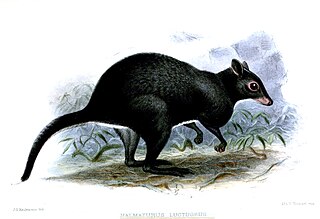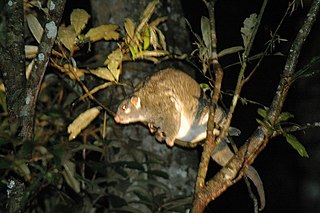
Gymnures, also called hairy hedgehogs or moonrats, are mammals belonging to the subfamily Galericinae, in the family Erinaceidae and the order Eulipotyphla. Gymnures resemble rats but are not closely related as they are not rodents; they are instead closely related to hedgehogs, which also belong to Erinaceidae. They are thought to have appeared in Eastern Asia before their closest relatives, and changed little from the original ancestor, which is thought to have been also the ancestor of the shrews.

Oreamnos is a genus of North American caprines. The mountain goat is the only living species. Until the end of the Pleistocene, another species, Oreamnos harringtoni, was distributed to the south of the recent form.

The Javan short-tailed gymnure is a small mammal from the family of the Erinaceidae. The scientific name of the species is first published by Salomon Müller in 1840. This species used to include the dorsalis, maxi, and peguensis subspecies, but these have now been elevated to species of their own: the Bornean short-tailed gymnure, Max's short-tailed gymnure, and the northern short-tailed gymnure. In addition, two new species were created from two other populations of H. suillus. The range of this species is now limited to Java.

The dwarf gymnure is a gymnure found only at Mount Kerinci, Sumatra, Indonesia. It is listed by the International Union for Conservation of Nature as a vulnerable species due to a restricted range.

Brachylagus is a genus of lagomorph that contains the smallest living leporid, the pygmy rabbit. One extinct species, Brachylagus coloradoensis, is also known.

Suncus is a genus of shrews in the family Soricidae.

The Bagobo rat is one of four species of rodent in the genus Bullimus in the Muridae family.
Geoxus is a genus of South American rodents in the tribe Abrotrichini of family Cricetidae. Two species—Geoxus valdivianus and Geoxus annectens are known.

Nectomys is a genus of rodent in the tribe Oryzomyini of family Cricetidae. It is closely related to Amphinectomys and was formerly considered congeneric with Sigmodontomys. It consists of five species, which are allopatrically distributed across much of South America: Nectomys grandis in montane Colombia; Nectomys palmipes on Trinidad and in nearby Venezuela, Nectomys apicalis in the western margins of the Amazon biome, Nectomys rattus in much of Amazonia, and Nectomys squamipes in the Atlantic Forest of Brazil. These species are generally semiaquatic, are normally found near water, and are commonly called water rats.
Nesoryzomys is a genus of rodent in the tribe Oryzomyini of family Cricetidae, endemic to the Galápagos Islands. Five species have been described, with two of them considered extinct.

Taphozous is a genus of the family Emballonuridae. The wide distribution of the genus includes several regions of Australia, Indonesia, Papua New Guinea and Africa. Taphozous comes from the Greek τάφος, meaning "a tomb". The common names for species include variants on sac-winged, sheathtail, or tomb bats.

Dorcopsis is a genus of marsupial in the family Macropodidae. The members of the genus are found on the island of New Guinea.

False ringtail possums (Pseudochirops) are members of a genus of marsupial in the family Pseudocheiridae. It contains the following species:
Podogymnura is a genus of mammal in the family Erinaceidae. It contains the following species:

The elegant water shrew is a species of mammal in the subfamily Soricinae of the family Soricidae. It is the only species within the genus Nectogale. It lives in Sikkim and China.

Megaderma is a genus of bat in the family Megadermatidae. It contains two living species:
Geoxus annectens, also known as Pearson's long-clawed akodont or Pearson's long-clawed mouse, is a species of rodent in the tribe Abrotrichini of family Cricetidae. Molecular data suggests that its closest relative is Geoxus valdivianus. Formerly classified in its own genus, Pearsonomys, named after American zoologist Oliver Payne Pearson, it was moved to Geoxus in 2016 after a morphological and genetic reevaluation of the tribe Abrotrichini. This rodent is endemic to Chile, where it is found in Nothofagus forest of the Valdivian temperate rainforest ecoregion.

Asian mole shrews (Anourosorex) are a genus of shrews that resemble moles, from China, Taiwan, India, and Indochina. They are the only known genus of the red-toothed shrew tribe Anourosoricini. The four known species are:

Mesechinus is a genus of hedgehogs. It contains five species from East Asia:

The long-eared gymnure is a eulipotyphlan that is found in Laos. This specific type of gymnure has long ears and a long skull compared to that of others. It is also recognized for its broad forefeet, stout claws, and naked hindfeet.

















